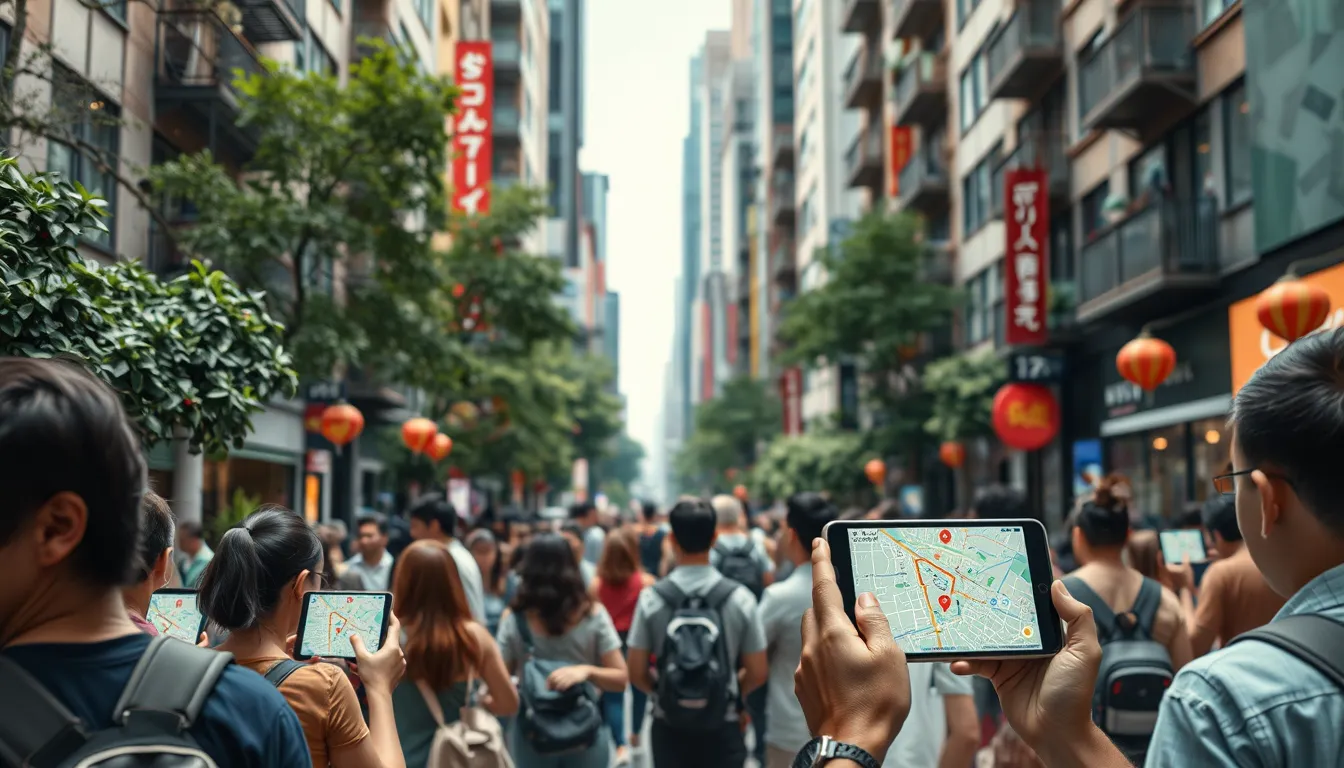Now Reading: Apple AI: Revolutionizing Navigation
-
01
Apple AI: Revolutionizing Navigation
Apple AI: Revolutionizing Navigation

Apple AI: Revolutionizing Navigation
Apple AI is redefining how we interact with navigation technology by integrating state-of-the-art machine learning with real-time, crowd-sourced visual data. Leveraging the impressive capabilities of the Maps Look Around feature, Apple is setting a new standard for precision and reliability in route guidance. This innovative approach not only enhances the accuracy of navigation tools but also underscores Apple’s commitment to using advanced technology in a responsible and privacy-conscious manner.
How Apple Maps Look Around for AI Navigation Works
At the heart of this technological breakthrough is Apple’s sophisticated method of gathering detailed, real-time visual data using its Maps Look Around function. The process begins with the collection of high-resolution images captured along roads and pathways across the globe. These images, sourced from a community of contributors and specially equipped vehicles, are then analyzed by Apple AI to extract important navigational cues such as road markings, signage, and environmental conditions.
Apple AI utilizes deep learning algorithms that process this vast amount of data. These algorithms are trained on millions of images, enabling the system to recognize patterns and subtle cues that may elude standard navigation technologies. By continuously learning from new data inputs, the system can dynamically update maps and suggest optimal routes in real time. This ensures that users not only get the most accurate directions but also benefit from insights derived from the latest visual information available.
- Enhanced Navigation Accuracy: The high-resolution image data allows for pinpoint precision. Apple AI is able to differentiate between similar-looking pathways and identify minor obstacles or detours that could affect travel time.
- Robust Machine Learning Models: The continuous influx of fresh data enables the machine learning models to adapt to changing environments, such as temporary roadblocks or construction, thereby enhancing predictive navigation capabilities.
- Seamless Integration: The integration of Look Around data into existing navigation tools ensures a smooth user experience, allowing for real-time updates without any noticeable delays in the user’s navigation app.
Privacy Focused AI Innovation from Apple
As Apple continues to innovate, the company places a significant emphasis on privacy and security. In an era where data breaches and privacy concerns are common, Apple AI sets itself apart by incorporating robust privacy measures into its data collection processes. The organization’s stringent protocols ensure that while the system learns from crowd-sourced images, the individual privacy of users remains uncompromised.
Apple employs several privacy-preserving techniques in its AI workflow:
- Data Anonymization: Before any image is used to train machine learning models, all identifiable details are meticulously scrubbed out. This guarantees that personal data is never exposed or misused.
- Secure and Transparent Data Collection: The data gathering process is designed with security at its core. Encryption and secure transmission protocols ensure that data integrity is maintained from the point of collection to its final processing stage.
- User Consent and Control: Apple empowers users by providing clear options regarding their data. The methods employed adhere to high standards of transparency, and users can opt out if they prefer not to contribute to this collective dataset.
Key Advantages of the Apple AI Approach
- Improved Navigation Details: Enhanced image resolution and precision ensure that navigation paths are as detailed and accurate as possible. Even subtle roadway features are captured and processed, providing drivers with directions that reflect real-world conditions.
- Dynamic Machine Learning Integration: The continuous stream of data from the Look Around feature allows the system to revise and refine its machine learning models regularly. This dynamic approach means that as road situations change, the navigation tool evolves in real time, leading to consistently updated and efficient routes.
- Enhanced User Experience: By integrating cutting-edge AI technology with traditional navigation systems, Apple creates an intuitive and responsive user interface. This results in fewer errors, more reliable directions, and an overall smoother journey for the user.
- Commitment to Privacy: The strong focus on privacy means that users can benefit from state-of-the-art navigation technology without sacrificing personal security. Apple’s robust data anonymization and security measures offer peace of mind alongside technological innovation.
Advanced Machine Learning Techniques in Navigation
The robust framework behind Apple AI is built on advanced machine learning techniques that allow for the intricate interpretation of complex visual data. These techniques include convolutional neural networks (CNNs), which excel at processing grid-like data such as images and videos, and recurrent neural networks (RNNs), which are adept at handling sequential information. Apples’s models are designed to decipher landscapes, detect patterns in the arrangement of roads, and anticipate changes in real time.
For example, CNNs are used extensively in the image analysis phase to identify important features such as road signs, crosswalks, and even temporary obstructions like construction zones. RNNs assist in processing the temporal dimension of the data, such as sudden weather changes or transient light conditions that might impact the visibility of key navigational markers. By combining these models, Apple AI is capable of delivering insights that are both granular and contextually aware.
Furthermore, the technique of transfer learning is often utilized to refine these models. This approach leverages pre-trained neural networks that have been honed on vast datasets and adapts them to the specific needs of navigation systems. The result is an AI system that continuously learns and improves while remaining resilient to varying environmental factors.
User Experience and Interface Improvements
The integration of Apple AI into navigation is not just a technical win; it’s a user-centric revolution. The enhanced data processing capabilities result in more intuitive user interfaces and user experiences. Navigation apps employing Apple AI benefit from real-time route adjustments, clear visual representations of roads, and minimal lag between data collection and update.
- Real-Time Updates: As the system processes new visual data, users receive up-to-the-minute corrections to their routes. This feature is especially beneficial in dynamic urban environments or areas with frequently changing road conditions.
- Intuitive Visual Cues: The high-quality images and detailed maps provide not just directions but also context. Drivers can easily interpret visual signals such as lane markers, pedestrian crossings, or changes in road conditions.
- Streamlined Interactions: The integration of AI enhances the responsiveness of the application, reducing the complexity of the user interface while providing comprehensive and actionable information quickly.
Comprehensive Technology Integration with the Apple Ecosystem
One of the most impressive aspects of Apple AI is how seamlessly it integrates with the larger Apple ecosystem. From iPhones to in-car entertainment systems, the technology is designed to be interoperable across devices. This universal design ensures that users receive a consistent experience regardless of the device they use.
- Cross-Platform Consistency: Users experience uniform navigation guidance across all their Apple devices. Whether they are using an iPhone, an iPad, or a connected vehicle system, the AI-driven navigation remains consistent and reliable.
- Enhanced Data Sharing: The synergy between devices allows for better data collection and sharing within the ecosystem. This, in turn, improves the accuracy and richness of the navigational data available to the AI system.
- Future-Ready Innovation: As Apple continues to introduce new devices and services, the integrated nature of its ecosystem ensures that innovations in AI navigation are rapidly disseminated, keeping each device at the forefront of technology.
Future Directions and Innovations in Navigation
Looking ahead, Apple AI is poised to drive even more transformative changes in the navigation landscape. With continuous improvements in machine learning and data integration, we can expect the following future developments:
- Predictive Navigation: Using historical data combined with real-time inputs, future iterations of Apple AI may predict traffic patterns, hazardous road conditions, or potential detours before they occur, thereby planning routes that preemptively avoid common issues.
- Augmented Reality Enhancements: The integration of augmented reality (AR) with AI navigation could offer overlay information directly onto the physical world. Imagine looking through your phone’s camera or car windshield to see highlighted routes, upcoming turns, or points of interest in real time.
- Personalized Routing: Future developments may also include the ability for the navigation system to learn individual travel habits, preferences, and even driving styles. This could result in personalized route suggestions that maximize efficiency and comfort.
- Expanded Global Coverage: As Apple continues to expand its data collection and refine its machine learning models, the navigation tool will become more accurate and detailed across more regions. This includes improving navigation in rural or previously under-mapped areas.
Challenges and Considerations
Despite the significant advancements, the implementation of AI-driven navigation is not without its challenges. Some of the primary concerns include:
- Data Privacy and Security: While Apple has implemented several protective measures, the need for continuous vigilance remains paramount as data breaches and misuse are persistent risks. Maintaining user trust through rigorous security protocols is essential.
- Scalability: As the volume of collected data increases, ensuring that the system scales efficiently without compromising on speed or accuracy is a technical challenge that requires ongoing innovation in data processing and algorithm optimization.
- Ethical Considerations: The usage of crowd-sourced data, even when anonymized, brings ethical questions regarding consent and data ownership. Apple must balance technological progress with ethical responsibility to its users.
- Adapting to Rapid Changes: The dynamic nature of real-world environments demands that AI models are constantly updated. Ensuring that these models remain accurate over time, even as road conditions and urban landscapes change, is an ongoing area of development.
Conclusion
Apple AI is at the forefront of transforming modern navigation technology. By harnessing the extensive capabilities of the Maps Look Around feature, Apple is not only refining the way routes are determined but also setting new benchmarks in accuracy, efficiency, and user experience. The integration of advanced machine learning techniques, combined with a steadfast commitment to privacy and data security, ensures that users enjoy superior navigation tools that evolve with the demands of real-world travel.
The future of navigation is bright, with innovations such as predictive modeling, augmented reality, and personalized routing on the horizon. Each of these advances will further enhance the experience, making travel safer and more intuitive. As Apple continues to lead the charge with its groundbreaking use of crowd-sourced visual data and cutting-edge AI, it is clear that the landscape of modern navigation will be defined by innovation that respects and safeguards user privacy.
In sum, Apple AI embodies the next generation of navigation technology—one that is precise, dynamic, and deeply committed to delivering an outstanding user experience. Whether you are a daily commuter or an occasional traveler, the advancements powered by Apple AI promise to make every journey more informed, secure, and enjoyable. As technology continues to evolve, stakeholders across industries will undoubtedly look to Apple’s innovative strategies as a blueprint for seamlessly integrating AI with everyday systems.
Apple’s pursuit of excellence in navigation technology is not only a testament to its leadership in the tech industry but also a considerable leap forward in how artificial intelligence can fundamentally enhance our day-to-day lives. With an eye on future enhancements and a deep respect for privacy and ethical data practices, Apple AI is setting a standard that others in the tech community will aspire to. This blend of innovation and responsibility is what truly marks the evolution of navigation for the modern world.

























